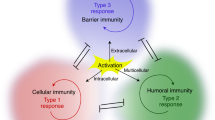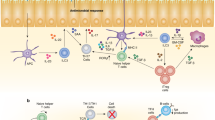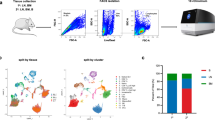Abstract
Although B cells produce cytokines it is not known whether B cells can differentiate into effector subsets that secrete polarized arrays of cytokines. We have identified two populations of “effector” B cells (Be1 and Be2) that produce distinct patterns of cytokines depending on the cytokine environment in which the cells were stimulated during their primary encounter with antigen and T cells. These effector B cell subsets subsequently regulate the differentiation of naïve CD4+ T cells to TH1 and TH2 cells through production of polarizing cytokines such as interleukin 4 and interferon γ. In addition, Be1 and Be2 cells could be identified in animals that were infected with pathogens that preferentially induce a Type 1 or Type 2 immune response. Together these results suggest that, in addition to their well defined role in antibody production, B cells may regulate immune responses to infectious pathogens through their production of cytokines.
This is a preview of subscription content, access via your institution
Access options
Subscribe to this journal
Receive 12 print issues and online access
$209.00 per year
only $17.42 per issue
Buy this article
- Purchase on SpringerLink
- Instant access to full article PDF
Prices may be subject to local taxes which are calculated during checkout





Similar content being viewed by others
References
Abbas, A. K., Murphy, K. M. & Sher, A. Functional diversity of helper T lymphocytes. Nature 383, 787–793 ( 1996).
O'Garra, A. Cytokines induce the development of functionally heterogenous T helper cell subsets. Immunity 8, 275– 283 (1998).
Croft, M., Carter, L., Swain, S. L. & Dutton, R. W. Generation of polarized antigen-specific CD8 effector populations: reciprocal action of interleukin (IL)-4 and IL-12 in promoting type 2 versus type 1 cytokine profiles . J. Exp. Med. 180, 1715– 1728 (1994).
Sad, S., Marcotte, R. & Mosmann, T. R. Cytokine-induced differentiation of precursor mouse CD8+ T cells into cytotoxic CD8+ T cells secreting Th1 or Th2 cytokines. Immunity 2, 271– 279 (1995).
Coyle, A. J. et al. Virus-specific CD8+ cells can switch to interleukin 5 production and induce airway eosinophilia. J. Exp. Med. 181, 1229–1233 (1995).
Peritt, D. et al. Differentiation of human NK cells into NK1 and NK2 subsets. J. Immunol. 161, 5821–5824 (1998).
Rissoan, M.-C. et al. Reciprocal control of T helper cell and dendritic cell differentiation . Science 283, 1183–1186 (1999).
O'Garra, A. et al. Production of cytokines by mouse B cells: B lymphomas and normal B cells produce interleukin 10. Int. Immunol. 2, 822–831 (1990).
Van Snick, J. Interleukin-6: an overview. Annu. Rev. Immunol. 8, 253–278 (1990).
Ware, C. F., VanArsdale, T. L., Crowe, P. D. & Browning, J. L. The ligands and receptors of the lymphotoxin system. Curr. Top. Microbiol. Immunol. 198, 175–218 (1995).
Pistoia, V. Production of cytokines by human B cells in health and disease. Immunol. Today 18, 343–350 (1997).
Kouskoff, V. et al. Antigens varying in affinity for the B cell receptor induce differential B lymphocyte responses. J. Exp. Med. 188 , 1453–1464 (1998).
Kindler, V., Matthes, T., Jeannin, P. & Zubler, R. H. Interleukin-2 secretion by human B lymphocytes occurs as a late event and requires additional stimulation after CD40 cross-linking. Eur. J. Immunol. 25, 1239–1243 (1995).
Taira, S., Matsui, M., Hayakawa, K., Yokoyama, T. & Nariuchi, H. Interleukin 2 secretion by B cell lines and splenic B cells stimulated with calcium ionophore and phorbol ester. J. Immunol. 139, 2957–2964 (1987).
Heinzel, F. P., Rerko, R. M., Hatam, F. & Locksley, R. M. IL-2 is necessary for the progression of Leishmaniasis in susceptible murine hosts. J. Immunol. 150, 3924–3933 (1993).
Bastien, Y. et al. Detection of functional platelet-activating factor receptors on human tonsillar B lymphocytes. J. Immunol. 162, 5498–5505 (1999).
Ohnishi, E., Iwata, T., Inouye, S., Kurata, T. & Sairenji, T. Interleukin-4 production in Epstein-Barr Virus transformed B cell lines from peripheral mononuclear cells of patients with atopic dermatitis . J. Int. Cyt. Res. 17, 597– 602 (1997).
Okamura, H., Kashiwamura, S. -I., Tsutsui, H., Yoshimoto, T. & Nakanishi, K. Regulation of interferon-γ production by IL-12 and IL-18. Curr. Opin. Immunol. 10, 259–264 (1998).
Schultze, J. L. et al. Human non-germinal center B cell interleukin (IL)-12 production is primarily regulated by T cell signals CD40 ligand, interferon γ, and IL-10: Role of B cells in the maintenance of T cell responses. J. Exp. Med. 189, 1–11 ( 1999).
Sartori, A. et al. Interleukin-12: an immunoregulatory cytokine produced by B cells and antigen-presenting cells. Methods 11, 116–127 (1997).
Endres, R. et al. Mature follicular dendritic cell networks depend on expression of lymphotoxin beta receptor by radioresistant stromal cells and of lymphotoxin beta and tumor necrosis factor by B cells. J. Exp. Med. 1999, 159–168 (1999).
Fu, Y. -X., Huang, G., Wang, Y. & Chaplin, D. D. B lymphocytes induce the formation of follicular dendritic cell clusters in a lymphotoxin α-dependent fashion. J. Exp. Med. 187, 1009– 1018 (1998).
Gonzalez, M., Mackay, F., Browning, J. L., Kosco-Vilbois, M. H. & Noelle, R. J. The sequential role of lymphotoxin and B cells in the development of splenic follicles. J. Exp. Med. 187, 997–1007 (1998).
Haynes, L., Linton, P.-J., Eaton, S. M., Tonkonogy, S. L. & Swain, S. L. Interleukin 2, but not other common γ chain-binding cytokines, can reverse the defect in generation of CD4 effector T cells from naïve T cells of aged mice. J. Exp. Med. 190, 1013–1023 (1999).
Kaye, J. et al. Selective development of CD4+ T cells in transgenic mice expressing a class II MHC-restricted antigen receptor. Nature 341, 746–749 ( 1989).
Goodnow, C. C. et al. Altered immunoglobulin expression and functional silencing of self-reactive B lymphocytes in transgenic mice. Nature 334, 676–682 (1988).
Mosmann, T. R., Cherwinski, H., Bond, M. W., Giedlin, M. A. & Coffman, R. L. Two types of murine helper T cell clones. I. Definition according to profiles of lymphokine activities and secreted proteins. J. Immunol. 136, 2348–2357 (1986).
Denkers, E. Y. T lymphocyte-dependent effector mechanisms of immunity to Toxoplasma gondii . Microbes Infect. 9, 699– 708 (1999).
Yap, G. S. & Sher, A. Cell-mediated immunity to Toxoplasma gondii: initiation, regulation and effector function. Immunobiology 2, 240–247 ( 1999).
Finkelman, F. D. et al. Cytokine regulation of host defense against parasitic gastrointestinal nematodes: Lessons from studies with rodent models. Annu. Rev. Immunol. 15, 505–533 ( 1997).
Chestnut, R. W. & Grey, H. M. Studies on the capacity of B cells to serve as antigen presenting cells. J. Immunol. 126, 1075–1079 ( 1981).
Chestnut, R. W., Colon, S. M. & Grey, H. M. Antigen presentation by normal B cells, B cell tumors and macrophages: Functional and biochemical comparison. J. Immunol. 128, 1764–1768 ( 1982).
Kuchroo, V. J. et al. B7–1 and B7-2 costimulatory molecules activate differentially the Th1/Th2 developmental pathways: application to autoimmune disease therapy . Cell 80, 707–718 (1995).
Elkins, K. L., Bosio, C. M. & Rhinehart-Jones, T. R. Importance of B cells, but not specific antibodies, in primary and secondary protective immunity to the intracellular bacterium Francisella tularensis Live Vaccine Strain. Infect. Immun. 67, 6002–6007 ( 1999).
Mastroeni, P., Simmons, C., Fowler, R., Hormaeche, C. E. & Dougan, G. Igh-6 (B cell deficient) mice fail to mount solid acquired resistance to oral challenge with virulent Salmonella enteric a Serovar Typhimurium and show impaired Th1 T-cell responses to Salmonella Antigens . Infect. Immun. 68, 46– 53 (2000).
Leef, M., Elkins, K. L., Barbic, J. & Shahin, R. D. Protective immunity to Bordetella pertussis requires both B cells and CD4+ T cells for key functions other than specific antibody production. J. Exp. Med. 191, 1841– 1852 (2000).
Ferru, I., Roye, O., Delarcre, M., Auriault, C. & Wolowczuk, I. Infection of B-cell-deficient mice by the parasite Schistosoma mansoni: Demonstration of the participation of B cells in granuloma modulation. Scand. J. Immunol. 48, 233–240 (1998).
Yang, X. & Brunham, R. C. Gene knockout B cell-deficient mice demonstrate that B cells play an important role in the initiation of T cell responses to Chlamydia trachomatis (Mouse pneumonitis) lung infection. J. Immunol. 161, 1439– 1446. (1998).
Langhorne, J., Cross, C., Seixas, E., Li, C. & von der Weid, T. A role for B cells in the development of T cell helper function in a malaria infection in mice. Proc. Natl Acad. Sci. USA 95, 1730–1734 ( 1997).
Homann, D. et al. Evidence for an underlying CD4 helper and CD8 T-cell defect in B-cell-deficient mice: Failure to clear persistent virus infection after adoptive immunotherapy with virus-specific memory cells from μMT/μMT mice. J. Virol. 72, 9208– 9216 (1998).
Mozdzanowska, K., Maiese, K. & Gerhard, W. Th cell-deficient mice control influenza infection more effectively than Th- and B cell-deficient mice: Evidence for a Th-independent contribution by B cells to virus clearance. J. Immunol. 164, 2635–2643 (2000).
Harding, F. A. & Allison, J. P. CD28-B7 interactions allow the induction of CD8+ cytotoxic T lymphocytes in the absence of exogenous help. J. Exp. Med. 177, 1791–1796 (1993).
Lund, F. E., Yu, N., Kim, K. -M., Reth, M. & Howard, M. C. Signaling through CD38 augments B cell antigen receptor (BCR) responses and is dependent on BCR expression. J. Immunol. 157, 1455–1467 ( 1996).
Openshaw, P. et al. Heterogeneity of intracellular cytokine synthesis at the single-cell level in polarized T helper 1 and T helper 2 populations. J. Exp. Med. 182, 1357–1367 ( 1995).
Johnson, L. L. A protective role for endogenous tumor necrosis factor in Toxoplasma gondii infection. Infect. Immun. 60, 3719– 3724 (1992).
Jacobson, R. H., Brooks, B. O. & Cypess, R. H. Immunity to Nematospiroides dubius: Parasite stages responsible for and subject to resistance in high responder (LAF1/J) mice. J. Parasitol. 68, 1053– 1058 (1982).
Acknowledgements
We thank T. Randall and S. Smiley for discussion and their comments on the manuscript. Supported by NIH grants AI22125 (to D. P. H. and S. L. S.) and AI43629 (to F. E. L.) and by the Trudeau Institute Inc.
Author information
Authors and Affiliations
Corresponding author
Supplementary information
Web Figure 1.
The influence of BCR ligation on expansion and cytokine production by effector B cells. Naïve B cells from MD4 BCR transgenic mice were cultured with mytomycin c treated TH1 or TH2 effector cells, PCCF, ± HEL as indicated, for 3 or 4 days. Cells cultured for 4 days received 100 ng/ml IL-2 on d 2 to prolong B cell viability. On days 3 and d4 the B cells were collected and repurified by positive selection using magnetic columns. After repurification >99% of the cells were CD19+, B220+. The repurified B cells were then stimulated in vitro with PMA + Ca2+ ionophore and supernatants were collected after 72 h. (a) B cell recovery on d 3 and d 4 after repurification. (b-d) Cytokine production by repurified, PMA + Ca2+ ionopho-rerestimulated B cells after culturing for 4 d with TH1 (open bars) or TH2 (solid bars) effector cells ± HEL as indicated. Cytokine production was measured by ELISA. (GIF 10 kb)
Web Figure 2.
In vitro polarization of naive T cells by Be1 and Be2 cells occurs in the absence of BCR ligation. Effector Be1 and Be2 cells were generated by culturing naïve B cells from MD4 BCR transgenic mice with mytomycin C treated TH1 and TH2 effector cells and antigen (PCCF + HEL) for 3 d. The Be1 and Be2 cells were collected, repurified by positive selection and cultured with purified naïve, CD4+ T cells from AND TCR transgenic mice (1:2 ratio), and PCCF + IL-2 alone, with PCCF + IL-2 + anti-IgM or with PCCF + IL-2 + HEL. The purity of the Be1, Be2 cells and naive CD4 T cells used in this experiment was > 98%. On d 4, T cells were collected, washed and restimulated in vitro with plate-bound anti-CD3 + soluble anti-CD28. Supernatants were collected at 24 and 72 h and tested for cytokines by bioassay or cytokine-specific ELISA. The cytokines produced by T cells incubated with Be1 effectors (+ or - antigen) is shown in open bars and the cytokines produced by T cells incubated with Be2 cells (± antigen) is shown in filled bars. The data are shown as maximum cytokine detected at either 24 or 72 hours (mean±s.d. of triplicate wells). (GIF 7 kb)
Rights and permissions
About this article
Cite this article
Harris, D., Haynes, L., Sayles, P. et al. Reciprocal regulation of polarized cytokine production by effector B and T cells. Nat Immunol 1, 475–482 (2000). https://doi.org/10.1038/82717
Received:
Accepted:
Issue Date:
DOI: https://doi.org/10.1038/82717



